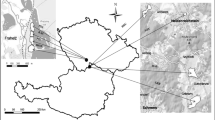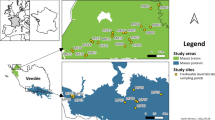Abstract
Impact of carp pond management upon macrozoobenthos assemblages was studied in inlet and outlet carp pond canals in South Moravia (Czech Republic). Four ponds (two eutrophic and two hypertrophic ones) with different types of fish farming management and intensification measures were selected for the evaluation of the impact of inlet water quality, discharge rate and pond stocking management upon the outlet water quality determinants based on macrozoobenthos evaluation during April–September 2009. Five inlet and four outlet canals were sampled by “kick–sampling” approach and also by using the artificial substrates. The pattern of water quality changes after the flow through the pond was predominantly influenced by inlet water quality. In ponds supplied with worsened inflow water quality with the saprobic index (SI) according to macrozoobenthos corresponding to alpha-mesosaprobity (SI 2.82–2.89), the outflow water quality was significantly improved by approximately half of the saprobic degree on SI 2.38–2.42. On the contrary, the inflow water quality corresponding to beta-mesosaprobity (SI, 2.32) was significantly (p < 0.01) deteriorated to alpha-mesosaprobity in the pond outflow. Macrozoobenthos diversity and the number of taxa reflected the flow through the pond identically with saprobic determinants. In ponds with poor inflow water quality, the number of macrozoobenthos taxa and its diversity increased in the outlet canals, and vice versa, in ponds with good-quality inflow water, the number of taxa and macrozoobenthos diversity decreased in outlet canals.
Similar content being viewed by others
Abbreviations
- SI:
-
Saprobic index
- MZB:
-
Macrozoobenthos
- MIAS:
-
Benthic macroinvertebrates colonising artificial substrates
- H′:
-
Shannon–Weaner index
- KUR:
-
Kurdějovský pond
- SD:
-
Standard deviation
- SIB:
-
Šibeník pond
- VCE:
-
Inlet canal Včelínek
- VAL:
-
Inlet canal Valtice
- NES:
-
Pond Nesyt
- VRK:
-
Pond Vrkoč
- DO:
-
Dissolved oxygen
- TN:
-
Total nitrogen
- TP:
-
Total phosphorus
- BOD5 :
-
Biochemical oxygen demand
- CC:
-
Common carp, Cyprinus carpio
- CI:
-
Grass carp, Ctenopharyngodon idella
- AN:
-
Bighead carp, Aristichthys nobilis
- HM:
-
Silver carp, Hypophthalmichthys molitrix
- EL:
-
Pike, Esox Lucius
- SL:
-
Zander, Stizostedion lucioperca
- TT:
-
Tench, Tinca tinca
- SG:
-
European catfish, Silurus glanis
- CF:
-
Coarse fish (predominantly common bream, Abramis brama, gibel carp, Carassius gibelio, roach, Rutilus rutilus, rudd, Scardinius erythrophthalmus, silver bream, Blicca bjoerkna, and others)
References
Adámek Z, Jurajda P (2002) Stream habitat or water quality—what influences stronger fish and macrozoobenthos biodiversity? Ecohydrol Hydrobiol 1(3):305–311
Adámek Z, Maršálek B (2012) Bioturbation of sediments by benthic macroinvertebrates and fish and its implication for pond ecosystems: a review. Aquac Int. doi:10.1007/s10499-012-9527-3
Adámek Z, Párová J, Stibranyiová I (1997) Perspectives of phytase application in feed mixtures for reduction of phosphorus amounts in fish farm effluents. Krmiva (Zagreb) 39(3):115–122
Baranova VP, Sakharov AM (1988) Method of estimation of water pollution in carp culture. In: sbornik nauch. trudov GosNII ozer. i rechn. rybn. khoz. NPO po prom. i teplovod. rybovod. 274:26–35
Begon M, Harper JL, Townsend CR (1996) Ecology, individuals, populations and communities. Blackwell, Oxford
Belic A, Popovic T (2005) Power of self-purification in some canals of Danube-Tisa-Danube Hydro-system. In: Lekkas TD (ed) 9th international conference on environmental science and technology, Athens
Billard R, Sevrin-Reyssac J (1993) Les impacts négatifs et positifs de la pisciculture d′étang sur l′environnement. In: Bamabé G, Kestemont P (eds) Production, environment and quality Bordeaux Aquaculture 92. European Aquaculture Society 18:17–22
Biswas JK, Rana S, Bhakta JN, Jana BB (2009) Bioturbation potential of chironomid larvae for the sediment-water exchange in simulated pond systems of varied nutrient enrichment. Ecol Eng 35:1444–1453
Boyd CE (1997) Practical aspects of chemistry in pond aquaculture. Prog Fish Culturist 59:85–93
Briao VB, Tavares CRG (2007) Effluent generation by the dairy industry: preventive attitudes and opportunities. Braz J Chem Eng 24(4):487–497
Burns D, Vitvar T, Mc Donnell J, Hassett J, Duncan J, Kendall C (2005) Effects of suburban development on runoff generation in the Croton River basin, New York, USA. J Hydrol 311(1–4):266–281
Butz I (1988) Situation of fish-farm effluents in Austria. Monistettuja Julkaisuja 74:4–12
Cairns J Jr (ed) (1982) Artificial substrates. Ann Arbor Science Publishers Inc., Ann Arbor
Chaloupková L, Adámek Z (2009) Fish assemblages in the canals of the Nesyt and Vrkoč pond systems (South Moravia, Czech Republic) In: 60 years of the study programme of the Fishery specialization at Mendel University of Agriculture and Forestry in Brno, MZLU, Brno, 4–5 Dec 2009
CSN 75 7716 (1998) Water quality—biological analysis—Saprobic index assessment. ČNI Praha
Gál D, Kerepeczki É, Szabó P, Pekár F (2008) A survey of environmental impact of pond aquaculture in Hungary. In: Aquaculture Europe 2008, EAS Spec Publ 37, Kraków, 15–18 Sept 2008
Giri S, Mukhtar S, Wittie R (2010) Vegetative covers for sediment control and phosphorus sequestration from dairy waste application fields. Trans ASABE 53(3):803–811
Gong ZJ, Xie P, Wang SD (2000) Macrozoobenthos in two shallow mesotrophic Chinese lakes with contrasting sources of primary production. J North Am Benthol Soc 19(4):709–724
Kainz E (1985) Zur Auswirkung von Karpfenteichabflussen auf die Wasserqualität von Vorflutern. Österreichs Fischerei 38(4):88–96
Kestemont P (1995) Different systems of carp production and their impacts on the environment. Aquaculture 129:347–372
Knud-Hansen CF, Hopkins KD, Guttman H (2003) A comparative analysis of the fixed—input, computer modeling, and algal bioassay approaches for identifying pond fertilization requirements for semi—intensive aquaculture. Aquaculture 228(1–4):189–214
Kokeš J, Němejcová D (2006) Methodology of running waters macrozoobenthos sampling and sample processing using the Perla method. VÚV TGM, Praha
Kolasa-Jamińska B (2002) The intensification of pond fish production and the magnitude of the waste load discharged during autumn harvesting. Arch Pol Fish 10(2):187–205
Kolasa-Jamińska B, Kuczynski M, Lewkowicz S, Pilarczyk M (2003) Elimination of nitrogen compounds in carp ponds fertilized with the biologically treated municipal sewage. Acta Sci Polonorum Piscaria 2(1):105–114
Lellák J (1965) The food supply as a factor regulating the population dynamics of bottom animals. Mitt Internat Verein Limnol 13:128–138
Leppa M, Hamalainen H, Karlajainen J (2003) The response of benthic macroinvertebrates to whole—lake biomanipulation. Hydrobiologia 498(1–3):97–105
Lewandowski J, Laskov C, Hupfer M (2007) The relationship between Chironomus plumosus burrows and the spatial distribution of pore-water phosphate, iron and ammonium in lake sediments. Freshw Biol 52:331–343
Manz D, Tschirschnitz M, Teichmann W (1988) Untersuchungen zum Einfluss von Teichwirschaften auf die Qualität der Fliessgewasser. Wasser Boden 11:615–619
Masseret E, Amblard C, Bourdier G (1998) Changes in the structure and metabolic activities of periphytic communities in a stream receiving treated sewage from a waste stabilization pond. Water Res 32(8):2299–2314
Morgan RA, Edwards FG, Brye KR, Burian SJ (2005) An evaluation of the urban stormwater pollutant removal efficiency of catch basin inserts. Water Environ Res 77(5):500–510
Muscutt AD, Harris GL, Bailey SW, Davies DB (1993) Buffer zones to improve water—quality—a review of their potential use in UK agriculture. Agric Ecosyst Environ 45(1–2):59–77
Nhan DK, Milstein A, Verdegem MCJ, Verreth JAV (2006) Food inputs, water quality and nutrient accumulation in integrated pond system: a multivariate approach. Aquaculture 261(1):160–173
Olah J (1986) Carp production in manured ponds. In: Billard R, Marcel J (eds) Aquaculture of Cyprinids. INRA, Paris
Oláh J, Szabó P, Esteky AA, Nezami SA (1994) Nitrogen processing and retention in Hungarian carp farm. J Appl Ichthyol 10:335–340
Pechar L (1995) Long–term changes in fish pond management as an unplanned ecosystem experiment: importance of zooplankton structure, nutrients and light for species composition of cyanobacterial blooms. Water Sci Technol 32:187–196
Potužák J, Huda J, Pechar L (2009) Changes in fish production effectivity in eutrophic fishponds—impact of zooplankton structure. Aquacult Int 15(3–4):201–210
Přikryl I (1996) Historical development of Bohemian fishpond management and its reflection in zooplankton structure (a possible criterion of biological value of ponds). In: Flajšhans M. (ed) Proceedings of Scientific Papers to the 75th. Anniversary of Foundation of the Research Institute of Fish Culture and Hydrobiology Vodňany, pp 153–166
Přikryl I, Janeček V, Raidl M, Filipová O (1983) The effect of the intensification of fish production on pond water quality. Bull VÚRH Vodňany 4:3–16
Rinella DJ, Feminella JW (2005) Comparison of benthic macroinvertebrates colonizing sand, wood, and artificial substrates in a low-gradient stream. J Freshw Ecol 20(2):208–220
Sládeček V (1973) System of water quality from the biological point of view. Archiv für Hydrobiologie, Beiheft Ergebnisse der Limnologie 7:1–218
Sládeček V, Tuček F (1975) Relation of the saprobic index to BOD5. Water Res 9(9):791–794
Svoboda M, Koubek P (1990) Stabilization system for waste water treatment and use. Acta Hydrochim Hydrobiol 18(1):71–80
Szücz I, Stündl L, Váradi L (2007) Carp farming in Central and Eastern Europe and a case study in multifunctional aquaculture. In: Leung P, Lee C-S, O′Bryen P (eds) Species and system selection for sustainable aquaculture, Blackwell Publ, Ames
Uehlinger U (1993) Primary production and respiration in the outlet of a eutrophic lake (River Glatt, Switzerland). Archiv für Hydrobiologie 128(1):39–55
Všetičková L, Adámek Z, Rozkošný M, Sedláček P (in press) Environmental impacts of semi-intensive carp pond farming on discharged water quality. Acta Ichthyologica et Piscatoria
White MJ, Storm DE, Busteed PR, Smolen MD, Zhang HL, Fox GA (2010) A quantitative phosphorus loss assessment tool for agricultural fields. Environ Model Softw 25(10):1121–1129
Zoccarato I, Benatti G, Calvi SL, Bianchini ML (1995) Use of pig manure as fertilizer with and without supplement feed in pond carp production in northern Italy. Aquaculture 129(1–4):387–390
Acknowledgments
This study forms part of the projects undertaken within CENAQUA CZ.1.05/2.1.00/01.0024 (South Bohemian Research Centre of Aquaculture and Biodiversity of Hydrocenoses), GA JU 047/2010/07 and VaV SP/2e7/73/08.
Author information
Authors and Affiliations
Corresponding author
Appendix
Rights and permissions
About this article
Cite this article
Všetičková, L., Adámek, Z. The impact of carp pond management upon macrozoobenthos assemblages in recipient pond canals. Aquacult Int 21, 897–925 (2013). https://doi.org/10.1007/s10499-012-9565-x
Received:
Accepted:
Published:
Issue Date:
DOI: https://doi.org/10.1007/s10499-012-9565-x




